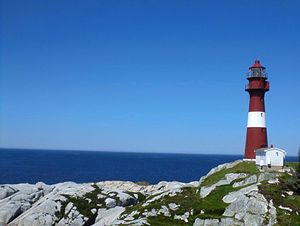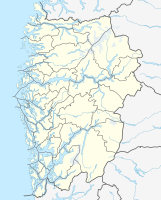Slåtterøy fyr
| Slåtterøy fyr | ||
|---|---|---|
| Slåtterøy fyr | ||
| Place: |
|
|
| Location: | Slåtterøy island | |
| Geographical location: | 59 ° 54 ′ 29 " N , 5 ° 4 ′ 2" E | |
| Height of tower base: | 24 moh. | |
| Fire carrier height : | 25 m | |
| Fire height : | 45.8 m | |
|
|
||
| Identifier : | Fl (2) W 30s | |
| Scope knows: | 18.5 nm (34.3 km ) | |
| Operating mode: | Automated since 1988, under monument protection since 1999, uninhabited since 2003 | |
| Function: | Coastal fire | |
| Construction time: | 1859 | |
| Operating time: | since 1859 | |
| International ordinal number: | B3752 | |
Slåtterøy fyr is a lighthouse on the island of Slåtterøy in the island municipality of Bømlo in the Norwegian province of Vestland , about halfway between the towns of Haugesund and Bergen .
location
The lighthouse is in the northern part of Slåtterøy, which is the northernmost built-up island of Bømlos. It marks the entrance to the Selbjørnsfjord . Together with Ryvarden fyr further south and Marstein fyr in the north, it shows the way along the rugged coast to Bergen. It also shows the entrance to the formerly important trading place Brandasund on the island of Gisøy , which in the 19th century was an important hub for the annual herring fishery that brought many foreign fishermen to the area.
history
It is believed that the name Slåtterøy is derived from the Old Norse slátr (German: slaughter) and suggests that seals were previously caught and slaughtered on the island .
In 1859 the lighthouse was built on the island. After Hellisøy fyr it was the second cast iron lighthouse in Vestland and the fourth oldest in Norway. It was produced in Bærums Verk and from there delivered in parts to the island. At the same time, a wooden lighthouse keeper's house and a boathouse were built in the southern part of the island. From the boathouse, a 450 meter long path leads up 140 brick steps to the foot of the lighthouse. First a fixed light was installed, which was replaced by a flashing light in the course of an expansion of the lighthouse in 1899. At the same time a house was built for the lighthouse assistant.
During the Second World War the lighthouse was occupied by German troops. In an Allied air raid on August 1, 1940, one of the lighthouse keeper's daughters was killed and another seriously injured. The lighthouse also received visible damage, some of which are still visible today. Among other things, the lens from 1901 was hit, but it is still installed. After the lighthouse was electrified in 1958, fewer people were required to operate the lighthouse. The assistant house was sold and demolished and the families of the lighthouse keepers left the island. Since electrification, Slåtterøy fyr has had the most powerful light of all Norwegian lighthouses. Due to its well-preserved building structure and its war history, the lighthouse and with it the entire northern part of the island was listed as a historical monument in 1999.
In 1988 Slåtterøy fyr was automated, but there was a lighthouse keeper and assistant until 2003. A year later, the Friends of Slåtterøy fyr (Venner av Slåtterøy fyr) was founded, offering overnight stays in the renovated lighthouse keeper's house.
See also
Web links
- Specifications of the lighthouse on the Kystverket website
Individual evidence
- ↑ a b Per Roger Lauritzen: Slåtterøy fyr. In: Store norske leksikon. June 23, 2020, accessed August 14, 2020 .
- ↑ a b c d Slåtterøy fyrstasjon. Norsk fyrhistorisk forening, accessed August 14, 2020 .
- ↑ a b c d Forvaltningsplan for Slåtterøy fyrstasjon. (pdf) Kystverket, December 10, 2015, accessed on August 14, 2020 (Norwegian).
- ↑ a b c Håvard Hammarstrøm: Stor interest for fyrferie på Slåtterøy. Bømlo-nytt, July 13, 2020, accessed August 14, 2020 .


